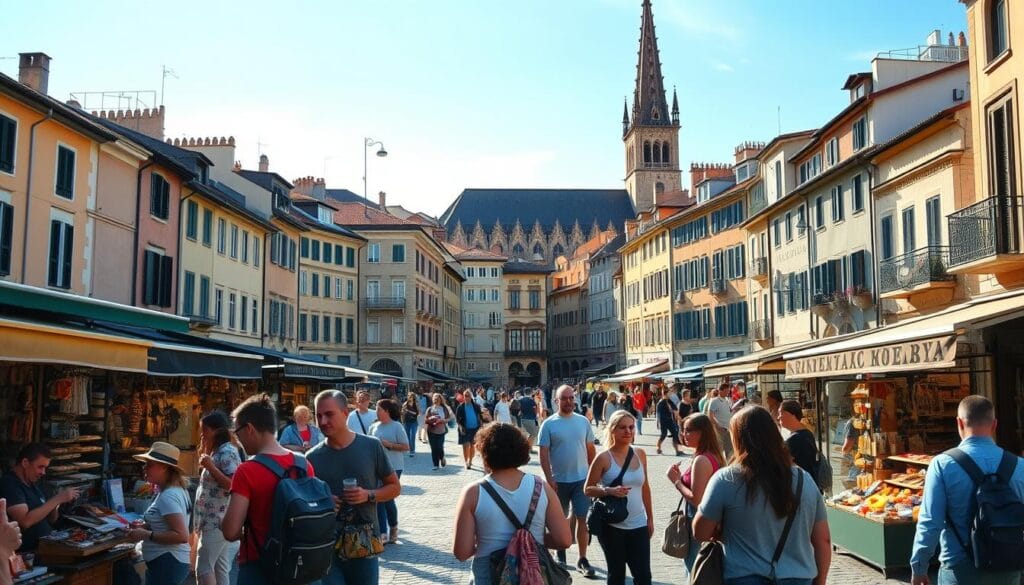Budget Travel Europe: Exploring Europe for Under $500

Every traveler dreams of Budget travel in Europe. Exploring Europe’s streets, cafes, and historic cities without spending a lot is a reality. Budget travel in Europe is an adventure waiting to happen. With the right planning, you can enjoy Budget travel Europe without emptying your wallet.
Imagine Budget travel Europe across countries, diving into different cultures, and making unforgettable memories for under $500. Cheap flights to Europe are easier to find than ever. With some smart tips, your dream Budget travel Europe trip can become a reality.
Whether you’re a student, young professional, or just love to travel, exploring Europe doesn’t have to be expensive. By learning budget travel tips, you can discover a world of experiences without worrying about money.
Table of Contents
For those considering Budget travel Europe, knowing when to go can help maximize your experience while saving money.
Understanding the Basics of European Budget Travel
Starting a budget travel europe journey needs careful planning. With smart planning, your dream trip can be affordable. Knowing the basics helps you enjoy more while spending less.
Best Times to Visit Europe on a Budget
Choosing the right time is key for saving money. Here are some tips:
- Travel in shoulder seasons (April-May or September-October)
- Stay away from peak summer months when prices go up
- Look into winter destinations for big discounts
Essential Travel Documents and Requirements
Being prepared avoids expensive errors. Make sure you have:
- A valid passport with at least six months left
- A Schengen visa (if needed)
- Travel insurance papers
- Copies of important ID
Currency Exchange Tips and Strategies
| Strategy | Savings Potential |
|---|---|
| Use bank cards with no foreign transaction fees | Save up to 3% on every buy |
| Exchange currency at local banks | Avoid high airport rates |
| Carry a mix of cash and cards | Flexible spending options |
Pro tip: Some European cities offer free museum days and cheap attractions. For example, London’s museums are free. Many cities have cheaper cultural experiences during off-peak times.
Smart travelers know that budget travel in Europe is about strategic planning, not sacrificing experiences.
Budget Transportation Options Across Europe
Traveling Europe on a budget is easy. Smart travelers can see the continent without spending a lot. There are many affordable ways to get from one place to another.
Transportation can be the biggest cost when planning a trip to Europe. But, there are many ways to travel cheaply. This helps you save money.
Budget travel Europe is not only about saving money; it’s about experiencing the richness of culture without overspending.
Low-Cost Airlines and Flight Booking Strategies
Finding cheap flights to Europe is simpler than you think. Airlines like Ryanair and EasyJet have great deals:
- Flights can start as low as 15 EUR
- Booking 6 months in advance yields best prices
- One-way tickets can be as affordable as round trips
Train and Bus Travel Alternatives
When it comes to Budget travel Europe, transportation options can make or break your experience.
For those watching their budget, trains and buses are great options:
- FlixBus offers intercity travel starting at 5 EUR
- High-speed train tickets range from $30 to $110 USD
- Non-high-speed trains can cost as little as $15 per journey
City Transportation Passes and Savings
Look for transportation passes in cities to save money. Many European cities have affordable daily or weekly passes. These cover buses, metros, and trams.
Pro tip: Always compare transportation costs and book in advance to maximize your savings!
Budget travel europe: Affordable Destinations

Traveling on a budget in Europe doesn’t mean missing out on great experiences. You can find amazing affordable tours across Europe. Eastern Europe is especially good for travelers looking for great deals.
Here are some top budget-friendly spots in Europe:
- Albania (Tirana)
- Average one-bed Airbnb: $50
- Average pint cost: $3.70
- Incredibly affordable Mediterranean destination
- Croatia (Zagreb)
- Average one-bed Airbnb: $66
- Average tram ride: 44 cents
- Cheap public transportation and low dining costs
- Romania (Bucharest)
- Average one-bed Airbnb: $59
- Average pint cost: $1.94
- Rich history and extremely budget-friendly
Focus on these hidden gems for your budget travel in Europe. Places like Porto in Portugal offer great experiences without costing too much. You can find a one-bed Airbnb for $103 and meals for two for under $50.
Pro tip: Traveling during off-peak seasons can reduce your expenses by up to 50%!
Smart travelers can find affordable tours by choosing places with rich culture but low prices. Eastern European countries are perfect for this, offering great experiences at a low cost.
Accommodation Strategies for Budget Travelers
Traveling in Europe doesn’t have to be expensive. With smart choices, you can explore without spending a lot. Budget accommodations in Europe offer great ways to save money.
For those on a tight budget, hostels in Europe are the best choice. Prices vary a lot depending on where you are:
- Eastern Europe: Hostel beds start at $15 per night
- Western Europe: Hostel beds cost between $30-$60 per night
- Private hostel rooms: Prices range from $70 to $150 per night
Finding affordable lodging is key to ensuring your Budget travel Europe remains within reach.
Hostel Highlights and Social Benefits
Hostels are more than just a place to stay. They are social spots for travelers. You can enjoy:
- Free group dinners
- Welcome drinks
- Walking tours
- Free breakfast
- Communal kitchens
Alternative Accommodation Options
There are many other budget-friendly places to stay:
- Couchsurfing
- House-sitting platforms
- Budget Airbnb rentals
- University dormitories during summer breaks
Money-Saving Booking Tips
“The smartest travelers book strategically and save big!”
Here are some tips to save money on accommodations in Europe:
- Use price comparison websites
- Book directly with properties
- Join hostel loyalty programs
- Travel during shoulder seasons
- Consider multi-night stay discounts
With a little planning, you can find affordable and comfortable places to stay in Europe. This way, you won’t have to cut back on your travel experience.
Food and Dining on a Shoestring Budget
Traveling on a budget in Europe means finding creative ways to eat. You don’t have to spend a lot to enjoy tasty meals. With some smart tips, you can eat for as little as 4 euros a day.
Here are some key ways to save on food:
- Shop at local markets for fresh, affordable ingredients
- Utilize food courts in shopping malls
- Explore street food options like kebab stands
- Take advantage of lunch specials
Many European cities have affordable places to eat. In Vienna, you can get a meal for 2 euros at kebab stands. In Poland, food courts offer meals for under 2 euros. Self-catering can greatly cut down food costs, but watch out for food theft in hostels.
| Location | Budget Meal Cost | Savings Strategy |
|---|---|---|
| Vienna | 2 euros | Kebab stands |
| Poland | Less than 2 euros | Food court kilo places |
| General Europe | 4 euros/day | Market shopping |
For budget travelers, try picnicking and shopping at local markets. Buying bread, cheese, and fruits can be cheap and nutritious. By eating like locals, you save money and enjoy real European food.
Free and Low-Cost Activities in European Cities
Exploring Europe doesn’t have to be expensive. Budget travel in Europe offers many ways to enjoy rich cultural experiences without spending a lot. Smart travelers can find amazing activities that are either free or very cheap.

Thrifty Europe trip planning shows several ways to enjoy European cities affordably:
Free Walking Tours and Museum Experiences
Many European cities offer incredible free walking tours. These tours give deep insights into local history and culture. For example:
- Prague offers free tours of its historic Jewish Quarter
- London provides free entry to world-class museums like the National Gallery
- Lisbon’s Gulbenkian Museum offers free Sunday afternoon admission
City Parks and Public Spaces
Affordable European tours can explore stunning public spaces for free. Visit beautiful urban parks, historic squares, and architectural wonders without spending a penny.
| City | Free Attractions | Estimated Cost |
|---|---|---|
| London | Changing of the Guard | Free |
| Dubrovnik | Old Town Walking | Free |
| Budapest | Public Parks | Free |
Cultural Events and Festivals
Look out for free cultural events for authentic local experiences. Many cities host free concerts, street performances, and seasonal festivals. These offer great entertainment without extra cost.
Your budget travel in Europe can be filled with experiences. Research local event calendars and take advantage of these free and low-cost activities.
Money-Saving Travel Apps and Resources
Traveling on a budget in Europe needs smart digital tools. These tools help you save money and reduce stress. The right apps can make your trip affordable and fun.
For frugal travel tips in Europe, there are key apps to save money:
- Flight Deal Apps: Going (formerly Scott’s Cheap Flights) finds amazing airline discounts
- Transportation: Omio offers train tickets up to €21 cheaper than station prices
- Ridesharing: BlaBlaCar provides cheaper transportation options
- Navigation: CityMapper and Google Maps help you find your way around cities
Currency and financial management apps are vital for budget travelers. TransferWise supports over 750 global currency routes. Money Manager tracks your spending with visual graphs.
“Digital tools are a budget traveler’s best friend in Europe” – Travel Expert
Accommodation apps like Hostelworld, Booking.com, and Airbnb offer affordable places to stay. These platforms often have discounts and last-minute deals. They can save you a lot of money on your European trip.
Using these apps wisely can help you travel more in Europe without spending too much.
Local Transportation and City Navigation
Traveling Europe on a budget means finding smart ways to get around. It’s not about giving up on exploring—it’s about finding ways to do so without breaking the bank.
Understanding local transport can make your budget trips better. Each city has its own ways to travel cheaply and efficiently.
Public Transit Systems
European public transport is usually cheap and wide-ranging. Most cities have networks that make planning your trip easy and affordable.
- Single tickets often cover multiple transit modes (subway, bus, tram)
- 24-hour passes typically cost less than four individual fares
- Contactless payment options available in many cities
Walking and Cycling Options
Walking is the cheapest way to get around. Many European cities are great for walking, with small centers perfect for exploring.
- Free walking tours available in most major cities
- Bike rentals often cost between €10-€20 per day
- Dedicated bike lanes in many urban areas
Transportation Apps and Tools
Technology makes navigating cities easier on a budget.
| App Name | Key Features | Cost |
|---|---|---|
| Google Maps | Real-time transit information | Free |
| Citymapper | Detailed urban transit routes | Free |
| Rome2Rio | Multi-modal transportation planning | Free |
Pro tip: Download offline maps and transit apps before your trip to avoid roaming charges and ensure smooth navigation during your low-cost european vacations.
Safety Tips and Travel Insurance
When planning your thrifty Europe trip, knowing about travel insurance is key. Basic emergency medical coverage starts at just $60. This is a small price to pay for protection against high medical costs. Without insurance, a visit to the emergency room in the USA can cost between $1,000 to $3,000.
For budget-conscious backpackers, look for insurance that covers medical emergencies, trip cancellations, and lost luggage. GeoBlue offers medical insurance starting at $28.16, with $1 million in coverage and a $0 deductible. Credit cards like Chase Sapphire Preferred® also offer extra protection, including up to $10,000 in trip cancellation coverage per person.
Your safety plan should include travel insurance that fits your needs. Look for plans that cover medical evacuations, have reasonable deductibles, and protect against unexpected events. Some plans might not cover pre-existing conditions, so always read the details. With the right insurance, you can travel Europe with confidence, knowing you’re protected from financial risks.
Food plays a crucial role in Budget travel Europe; smart dining choices can significantly cut costs.
Budget travel needs careful planning, but investing in travel insurance can save you from big unexpected costs. Compare different plans, think about your destination’s risks, and pick coverage that gives you peace of mind on your European journey.
FAQ
Is it really possible to travel through Europe for under 0?
What are the cheapest months to travel to Europe?
Do I need a visa to travel to Europe?
What’s the most affordable way to get around Europe?
How much should I budget for daily expenses in Europe?
What are the best budget accommodation options in Europe?
How can I save money on food while traveling in Europe?
What are some free activities in European cities?
Is travel insurance necessary for a budget trip to Europe?
What’s the best way to avoid extra expenses while traveling?
Source Links
- How to Travel Europe for 2 Weeks for $1,500 (Including Flights) – https://thebudgetmindedtraveler.com/how-to-travel-europe-cheap/
- How to Travel Europe for Cheap! How Far a $2k Budget Can Get You – https://whereintheworldisnina.com/how-to-travel-europe-cheap/
- One-Month Europe Trip on a Budget: A Full Itinerary and Cost breakdown – https://www.kesslerelsewhere.com/blog/one-month-europe-trip-on-a-budget
- Affordable Europe – https://www.ricksteves.com/watch-read-listen/read/articles/affordable-europe
- Europe Budget Travel Guide (Updated 2025) – https://www.nomadicmatt.com/travel-guides/europe-travel-tips/
- 6 Cheap (and Best) Ways to Travel Europe in 2025 – https://www.nomadicmatt.com/travel-blogs/cheap-ways-to-travel-across-europe-2/
- Budget Flying Within Europe – https://www.ricksteves.com/travel-tips/transportation/budget-flights
- Travel in Europe on a Budget: A Complete Guide – https://www.joinmytrip.com/blog/en/travel-in-europe-on-a-budget-a-complete-guide/
- The 14 cheapest cities to visit in Europe in 2025 – https://www.timeout.com/europe/things-to-do/best-cheapest-cities-to-visit-in-europe-on-a-budget
- 9 Cheap Ways to Visit Europe | Volunteer Forever – https://www.volunteerforever.com/article_post/9-cheap-ways-to-visit-europe/
- Cheap places to travel in Europe during winter 2024 – https://www.tourhero.com/en/magazine/destinations/europe/cheap-places-to-travel-in-europe-during-winter-2024/
- Guide To Hostels in Europe | How to Pick The Perfect Hostel For Your Trip – https://thesavvybackpacker.com/hostels-in-europe-guide/
- How to travel Europe on a backpacker’s budget – https://www.worldpackers.com/articles/how-to-travel-europe-on-a-budget
- How to Tour Europe on a Budget in 2024 How to Tour Europe on a Budget in 2024 – https://www.libertytravel.com/travel-articles/how-to-tour-europe-on-a-budget-in-2024
- How to eat in Europe on a tight budget: 4 euros a day – https://www.journeywonders.com/eat-europe-tight-budget/
- Rick Steves’ Genius Tip For The Cheapest Meals You’ll Eat In Europe – Explore – https://www.explore.com/1738207/rick-steves-genius-tip-budget-meals-europe/
- 5 Best European Cities for Cheap or Free Attractions – https://www.graveltravel.com/blogs/gravel-travels/european-cities-free-attractions?srsltid=AfmBOoqbmHqg_1AMUKd_ThLeT1HkzVz46PfztXdeDk90U8ZRuGZuG9Be
- The Complete Europe for Free Itinerary • Kendyl Travels – https://kendyltravels.com/the-complete-europe-for-free-itinerary/
- 33 travel apps that will save you time and money in Europe – https://www.worldpackers.com/articles/travel-apps-that-will-save-you-time-and-money-in-europe
- The Best Travel Apps for 2025 – https://www.pcmag.com/picks/best-travel-apps
- 24 Best Travel Websites and Apps to Find Deals and Save You Money – https://www.kiplinger.com/slideshow/spending/t059-s001-24-best-travel-websites-to-save-you-money/index.html
- Tips and tricks on the cheapest way to get to Europe (and travel ar… – https://www.worldpackers.com/articles/cheapest-way-to-get-to-europe
- City Transit Tips for Europe – https://www.ricksteves.com/travel-tips/transportation/city-transit/city-transit-tips
- How to Get Around Europe for Cheap – North to South – https://northtosouth.us/booking-affordable-transportation-in-europe/
- Budget Traveler’s Guide To Travel Insurance – Budget Travel With Gabby – https://budgettravelwithgabby.com/budget-travelers-guide-to-travel-insurance/
- The Guide to Travel Insurance for Europe Trips – NerdWallet – https://www.nerdwallet.com/article/travel/travel-health-medical-insurance-europe
For Budget travel Europe enthusiasts, engaging in local customs can enhance your trip while being budget-friendly.
Free activities are abundant for those who want to stretch their Budget travel Europe even further.
Utilizing travel apps can aid in the journey of Budget travel Europe, making your planning more efficient.
Understanding local transportation is essential for Budget travel Europe, enabling easy navigation without overspending.
Budget travel Europe can also be enriched by considering safety tips for a worry-free journey.
In summary, Budget travel Europe can be both affordable and fulfilling if done wisely.

